Briggs And Stratton Generator Troubleshooting: Ultimate Guide
Briggs and Stratton Generator Troubleshooting: The most common reasons a generator won’t start are low coolant levels and loss of generator power. To fix a generator that doesn’t produce power, check for blown fuses or tripped circuit breakers and replace them if necessary.
If your Briggs and Stratton generator has a blinking blue light, it indicates that the CO shutdown system is functioning properly. Other issues that can affect a generator’s performance include a restricted or damaged air filter, a faulty spark plug, and a dead or drained battery. If you notice fluid pooling around your generator, it could be a sign of a fuel or coolant leak.

Reasons For No Power
When it comes to troubleshooting your Briggs and Stratton generator, one of the most common issues you may encounter is a lack of power. This can be frustrating, especially if you’re relying on the generator during a power outage or for outdoor events. However, understanding the reasons behind the lack of power can help you quickly identify and fix the problem.
Tripped Circuit Breaker
If your Briggs and Stratton generator is not producing any power, the first thing you should check is the circuit breaker. A tripped circuit breaker can easily cut off the power supply to the generator. To troubleshoot this issue, follow these steps:
- Locate the circuit breaker on your generator. It is usually located near the control panel.
- Check if the circuit breaker is in the “ON” position. If it has been tripped, it will be in the “OFF” position.
- To reset the circuit breaker, switch it to the “OFF” position, then back to the “ON” position.
- Test the generator to see if power is restored.
Faulty Power Connection
If resetting the circuit breaker doesn’t solve the power issue, the next step is to check the power connection. A faulty power connection can prevent the generator from supplying electricity. Here’s what you should do:
- Inspect the power cord and ensure it is securely plugged into the generator.
- Check the outlet or electrical panel where the generator is connected. Make sure there is no loose connection or tripped breaker.
- If everything appears to be fine, try plugging the generator into a different outlet to rule out any issues with the current connection.
Blown Fuse
Another possible reason for no power is a blown fuse. A blown fuse can disrupt the flow of electricity and prevent the generator from functioning properly. To check for a blown fuse and resolve this issue, follow these steps:
- Locate the fuse box on your generator. It is usually located near the control panel.
- Inspect the fuses to see if any are blown. A blown fuse will have a broken filament or a charred appearance.
- Replace any blown fuses with new ones of the same rating.
- Test the generator to see if power is restored.
Low Fuel Levels
One often overlooked reason for no power in a Briggs and Stratton generator is low fuel levels. If the fuel tank is running empty or below a certain level, the generator may not be able to produce electricity. To address this issue, follow these steps:
- Check the fuel gauge on your generator to determine the fuel level.
- If the fuel level is low, add fuel to the tank. Make sure to use the recommended type of fuel for your generator.
- Once the fuel tank is filled to an adequate level, start the generator and test if power is restored.
By troubleshooting these common issues, you will be able to identify and resolve the no-power problem in your Briggs and Stratton generator, ensuring that it operates smoothly and provides the electricity you need.
Fixing No Power Issues
One of the most frustrating problems you may encounter with your Briggs and Stratton generator is a lack of power. When this happens, there are several troubleshooting steps you can take to fix the issue and restore power. In this section, we will discuss three common solutions for fixing no-power issues in Briggs and Stratton generators.
Resetting The Circuit Breaker
The first step in troubleshooting a generator with no power is to check the circuit breaker. The circuit breaker is designed to protect the generator from damage caused by overloading or short circuits. If the circuit breaker has tripped, it will need to be reset before power can be restored.
To reset the circuit breaker, follow these steps:
- Locate the circuit breaker on the generator panel.
- Switch the breaker to the “off” position.
- Wait for a few seconds, then switch the breaker back to the “on” position.
If the circuit breaker was the cause of the power issue, resetting it should restore power to the generator. However, if the breaker continues to trip, there may be an underlying problem that needs to be addressed.
Checking And Fixing Power Connections
If resetting the circuit breaker did not solve the no-power issue, the next step is to check the power connections. Loose or damaged connections can prevent the generator from receiving the power it needs to operate. Here’s how you can check and fix power connections:
- Inspect the power cables and connectors for any signs of damage or wear.
- Tighten any loose connections using a screwdriver or wrench.
- If you notice any damaged cables or connectors, replace them with new ones.
By ensuring all power connections are secure and free from damage, you can eliminate this as a possible cause of the no-power issue and increase the chances of restoring power to your generator.
Replacing Blown Fuses
In some cases, a generator may lose power due to blown fuses. Fuses are designed to protect the generator’s electrical system from excessive current flow. If a fuse blows, it will need to be replaced to restore power. Follow these steps to replace blown fuses:
- Locate the fuse panel on the generator.
- Identify the blown fuse by looking for a broken or melted wire inside the fuse.
- Remove the blown fuse by pulling it straight out of the socket.
- Insert a new fuse with the same amperage rating into the socket.
Replacing blown fuses should rectify any power issues caused by them. However, it’s important to determine the underlying cause of the blown fuses to prevent them from happening again.
By following these troubleshooting steps for fixing no power issues in your Briggs and Stratton generator, you can quickly restore power and ensure its reliable performance. Remember to always refer to your generator’s manual for specific instructions and safety guidelines when troubleshooting or performing any maintenance tasks.
Common Reasons For Failure To Start
When it comes to Briggs and Stratton generator troubleshooting, there are a few common reasons why your generator may fail to start. These issues can range from simple maintenance tasks to more complex engine problems. By understanding these common reasons, you can quickly diagnose and resolve the issue, ensuring that your generator is up and running in no time.
Low Oil Levels
One of the most common reasons why a Briggs and Stratton generator fails to start is due to low oil levels. A generator relies on proper lubrication to function smoothly, and if the oil levels are too low, it can cause the engine to seize up and shut down. To resolve this issue, check the oil levels and top it up if necessary. Regularly checking and maintaining proper oil levels is essential for the longevity and performance of your generator.
Dirty Air Filter
A dirty air filter can also prevent your Briggs and Stratton generator from starting. An air filter that is clogged with dirt and debris restricts the airflow, leading to inconsistent engine performance. To fix this, you should clean or replace the air filter regularly. It’s a simple maintenance task that can go a long way in ensuring the proper functioning of your generator.
Faulty Spark Plug
The spark plug plays a critical role in igniting the fuel-air mixture in the engine. If the spark plug is damaged or not properly attached, it can cause the generator to fail to start. Check the spark plug for any signs of wear or damage, and if necessary, replace it with a new one. Additionally, ensure that the spark plug is properly connected with the correct gap. Taking care of the spark plug is essential for the smooth operation of your Briggs and Stratton generator.
Carburetor Issues
Issues with the carburetor can also lead to a failure to start. The carburetor is responsible for mixing the fuel and air for combustion in the engine. If it becomes clogged or damaged, it can disrupt the fuel flow and prevent the generator from starting. Cleaning or repairing the carburetor may be necessary to resolve this issue. Regular maintenance and cleaning of the carburetor can help prevent such problems and keep your generator running smoothly.
Troubleshooting Won’t Start Issues
If you’re experiencing trouble starting your Briggs and Stratton generator, don’t worry! There are a few common issues that can easily be fixed to get your generator up and running again. In this section, we will explore the steps to troubleshoot and resolve won’t start issues with your generator.
Checking And Refilling Oil Levels
One of the first things you should check when troubleshooting a generator that won’t start is the oil level. Low oil levels can cause the generator to shut down as a safety measure. To check the oil level, follow these steps:
- Locate the oil dipstick on the side of the generator.
- Remove the dipstick and wipe it clean with a cloth.
- Reinsert the dipstick in, then remove it again to check the oil level.
- If the oil level is below the “full” mark, add the recommended oil type for your generator until it reaches the proper level.
Ensuring that your generator has the correct oil level is crucial for smooth operation. Remember to refer to the generator’s manual for specific oil recommendations.
Cleaning Or Replacing The Air Filter
The air filter plays a vital role in the performance of your generator. A clogged or dirty air filter can prevent the engine from getting the necessary airflow, resulting in difficulty starting or running poorly. Here’s how to clean or replace the air filter:
- Locate the air filter housing, usually found on the side or top of the generator.
- Remove the cover or screws that secure the housing.
- Carefully take out the air filter and inspect it for dirt, debris, or damage.
- If the filter is dirty, gently clean it with compressed air or by tapping it on a hard surface to remove excess dirt.
- If the filter is damaged or excessively dirty, replace it with a new one that matches the model and specifications of your generator.
- Reinstall the cleaned or new air filter, ensuring it is properly seated and the housing is securely closed.
Regularly cleaning or replacing the air filter will improve the overall performance and longevity of your generator.
Inspecting And Replacing The Spark Plug
A faulty or improperly installed spark plug can prevent your generator from starting. To check and replace the spark plug, follow these steps:
- Locate the spark plug on the engine of your generator.
- Using a spark plug socket wrench, carefully remove the spark plug from the engine.
- Inspect the spark plug for signs of damage, such as worn electrodes or a cracked porcelain insulator.
- If the spark plug appears damaged, replace it with a new one that matches the recommended spark plug type for your generator.
- Insert the new spark plug into the engine, making sure it is tightened securely but not over-tightened.
The spark plug is an essential component for generating the spark needed to ignite the fuel in the engine. Regularly inspecting and replacing the spark plug will help maintain optimal performance.
Cleaning Or Servicing The Carburetor
The carburetor is responsible for mixing fuel and air in the correct proportions for combustion. If the carburetor is dirty or clogged, it can cause starting issues. To clean or service the carburetor, please refer to the manufacturer’s instructions or consult a professional technician.
By following these troubleshooting steps, you should be able to diagnose and resolve common won’t start issues with your Briggs and Stratton generator. Remember to always refer to the generator’s manual for specific instructions and safety guidelines. Regular maintenance and proper troubleshooting will ensure that your generator performs reliably whenever you need it.
Understanding The Meaning Of A Blinking Blue Light
Understanding the Meaning of a Blinking Blue Light
When it comes to Briggs and Stratton generator troubleshooting, one important aspect to understand is the meaning behind a blinking blue light. The blinking blue light is an indication of the CO shutdown system functionality.
CO shutdown system functionality:
The CO shutdown system is a safety feature designed to protect you and your family from the dangers of carbon monoxide (CO) poisoning. Carbon monoxide is a colorless and odorless gas that can be produced by gasoline-powered generators, which can pose a serious threat if not properly managed.
The blinking blue light on your Briggs and Stratton generator serves as a visual confirmation that the CO shutdown system is functioning properly. It is a reassuring signal that your generator has the necessary safeguards in place to detect and mitigate the risks associated with CO emissions.
This feature is especially important when using your generator in enclosed spaces, such as during power outages or camping trips. The CO shutdown system ensures that if an unsafe level of CO is detected, the generator will automatically shut down to prevent the harmful gas from being released into the environment.
Indication of proper functioning of the generator:
When you see the blinking blue light upon starting your generator, it is a clear indication that the generator is operating correctly and that the CO shutdown system is active. This means that you can have peace of mind knowing that your generator is equipped with the necessary safety measures to protect you and your loved ones.
It is important to note that the blue light will only blink for approximately five seconds at the start-up of the generator. If the blinking continues for an extended period of time or if it flashes red instead of blue, it may indicate an issue with the CO shutdown system. In such cases, it is recommended to contact a Briggs and Stratton authorized service dealer for further assistance.
Conclusion:
Understanding the meaning of a blinking blue light on your Briggs and Stratton generator is essential for troubleshooting and ensuring the proper functioning of your generator’s CO shutdown system. This safety feature provides you with the confidence and peace of mind that you and your family are protected from the dangers of carbon monoxide emissions.
Resolving Blinking Blue Light Issues
If you own a Briggs and Stratton generator and notice a blinking blue light, it’s essential to address the issue promptly. The blinking blue light indicates a problem that requires troubleshooting and resolving. Ignoring this issue can lead to further complications and hinder the performance of your generator. In this section, we will discuss two methods to resolve blinking blue light issues: contacting an authorized service dealer and seeking professional assistance.
H3contacting An Authorized Service Dealer/h3
If you are experiencing a blinking blue light on your Briggs and Stratton generator, one option to resolve the issue is to contact an authorized service dealer. Authorized service dealers are knowledgeable experts who specialize in the maintenance and repair of Briggs and Stratton generators. They have the necessary skills and expertise to identify and address the problem effectively.
Contacting an authorized service dealer ensures that your generator is in the hands of professionals who understand the specific requirements of Briggs and Stratton generators. They are equipped with the right tools and diagnostic equipment to accurately diagnose the cause of the blinking blue light and provide the appropriate solution.
H3seeking Professional Assistance/h3
If you are uncertain about troubleshooting the blinking blue light issue on your Briggs and Stratton generator or prefer to have it resolved by professionals, seeking professional assistance is a recommended option. Professional assistance ensures that the problem is handled by experts who have extensive experience and knowledge in dealing with generator issues.
By seeking professional assistance, you can have peace of mind knowing that your generator will be thoroughly inspected and repaired if necessary. Professionals can identify any underlying issues contributing to the blinking blue light and take appropriate measures to resolve them. This ensures that your generator functions optimally and provides reliable power when you need it the most.
Whether you choose to contact an authorized service dealer or seek professional assistance, resolving blinking blue light issues on your Briggs and Stratton generator is crucial for maintaining its performance and longevity. Don’t hesitate to take action and address the issue promptly to avoid any further complications.
Importance Of Manuals And Resources
When it comes to troubleshooting a Briggs and Stratton generator, having access to the right manuals and resources is crucial. Whether you are a seasoned professional or a beginner, having a comprehensive guide to refer to can save you time and frustration. In this section, we will explore the importance of manuals and online resources for troubleshooting Briggs and Stratton generators.
Accessing The Official Manual For Briggs And Stratton Generators
One of the most valuable resources for troubleshooting Briggs and Stratton generators is the official manual provided by the manufacturer. This manual contains detailed instructions and diagrams that can help you identify and resolve common issues. Accessing the official manual is easy, and there are a few different ways to do it. Here are some options:
- Visit the Briggs and Stratton website and navigate to the support section. Look for the manual specific to your generator model and download it.
- If you have misplaced your physical copy of the manual, you can contact Briggs and Stratton customer support to request a new one.
- Some generator models may come with a digital copy of the manual stored on the generator itself. Refer to your generator’s documentation to learn how to access it.
Utilizing Online Resources For Troubleshooting Assistance
In addition to the official manual, there are various online resources available that can provide troubleshooting assistance for your Briggs and Stratton generator. These resources can be incredibly helpful, especially when you need quick answers or specific solutions. Here are a few online resources you can utilize:
- Briggs and Stratton’s official website: The support section of the Briggs and Stratton website contains a wealth of troubleshooting information, including FAQs, videos, and articles.
- Online forums and communities: There are many online forums and communities where generator owners and experts share their knowledge and experiences. Participating in these forums can help you find answers to specific issues.
- YouTube tutorials: YouTube is a fantastic resource for visual learners. There are many tutorial videos available that demonstrate troubleshooting steps for different Briggs and Stratton generator models.
By utilizing both the official manual and online resources, you can enhance your troubleshooting abilities and tackle any issues that may arise with your Briggs and Stratton generator. Remember to always refer to the official manual first, as it contains manufacturer-specific information and guidelines.
How To Use Manuals And Resources
When it comes to troubleshooting your Briggs and Stratton generator, having access to manuals and other resources can be incredibly helpful. Understanding the layout and organization of the manual, following step-by-step troubleshooting instructions, and exploring online forums and communities are all effective ways to identify and resolve any issues you may encounter. In this section, we will dive into each of these strategies to empower you with the knowledge and resources you need to tackle any generator-related problems that come your way.
Understanding The Layout And Organization Of The Manual
The first step in effectively using the manual for troubleshooting is to understand its layout and organization. The manual is typically divided into sections that cover different aspects of the generator’s operation and maintenance. These sections may include topics such as generator safety, starting and stopping procedures, troubleshooting common issues, and maintenance guidelines.
Within each section, you will find detailed instructions, diagrams, and troubleshooting charts that can help you identify and fix specific problems. Take the time to familiarize yourself with the table of contents and locate the relevant sections for your troubleshooting needs.
Following Step-by-step Troubleshooting Instructions
Once you have identified the section that addresses your generator’s issue, it’s time to follow the step-by-step troubleshooting instructions. These instructions are designed to guide you through the diagnostic process, helping you pinpoint the root cause of the problem.
Ensure that you read and understand each step before proceeding. Pay close attention to any warnings or precautions mentioned in the manual to ensure your safety while troubleshooting. Take notes or jot down any important information that can help you keep track of your progress and any potential solutions.
Exploring Online Forums And Communities For Additional Support
In addition to the manual, online forums, and communities can provide valuable support and insight when troubleshooting your Briggs and Stratton generator. These platforms allow users to share their experiences, ask questions, and receive advice from fellow generator owners and experts.
Utilize search engines to find relevant forums or communities dedicated to Briggs and Stratton generators. Join these platforms and actively engage with others. Describe your problem in detail and ask for guidance. Often, you will receive helpful suggestions, tips, and even solutions from individuals who have faced similar issues.
Remember, however, to critically evaluate the information you receive online. Consider the credibility and expertise of the sources, and cross-reference any advice with information from the official manual. Use online forums and communities as a supplementary resource to enhance your troubleshooting process.
In conclusion, utilizing manuals and resources is an essential aspect of troubleshooting your Briggs and Stratton generator. By understanding the layout and organization of the manual, carefully following step-by-step troubleshooting instructions, and exploring online forums and communities, you can effectively identify and resolve any issues that arise with your generator.
Frequently Asked Questions
What Is The Most Common Reason Generator Won’t Start?
The most common reason a generator won’t start is due to low coolant levels, which can cause the engine to overheat and shut down. Another common issue is a loss of power, usually caused by blown fuses or tripped circuit breakers.
Resetting the breaker and replacing blown fuses should solve the problem.
Why Does My Briggs And Stratton Generator Keep Shutting Off?
Common reasons why a Briggs and Stratton generator keeps shutting off include low coolant levels and loss of generator power. Low coolant levels can cause the engine to overheat and shut down. Troubleshooting the generator for any blown fuses or tripped circuit breakers may help resolve power loss issues.
How Do You Fix A Generator That Doesn’t Produce Power?
To fix a generator that doesn’t produce power, check if the fuse is blown or the circuit breaker is tripped. Reset the breaker and replace blown fuses. Identify the cause of the issue to prevent it from happening again.
Why Is My Briggs And Stratton Generator Blinking Blue Light?
A blinking blue light on your Briggs and Stratton generator indicates that the CO shutdown system is working properly. If you have concerns or need assistance, contact an authorized service dealer.
What Is The Most Common Reason A Generator Won’t Start?
The most common reason a generator won’t start is a low fuel level. Make sure to check the fuel gauge and fill up if needed.
Conclusion
To troubleshoot issues with your Briggs and Stratton generator, follow these steps. Firstly, check the coolant levels as low coolant can cause the generator to overheat and shut down. Secondly, if your generator isn’t producing power, it may have blown a fuse or tripped a circuit breaker.
Reset the breaker and replace blown fuses to resolve this issue. Lastly, if your generator is running rough, check the air filter, spark plug, and fuel pressure for any problems. By addressing these common issues, you can ensure your generator runs smoothly and efficiently.






